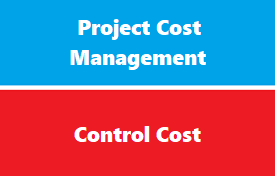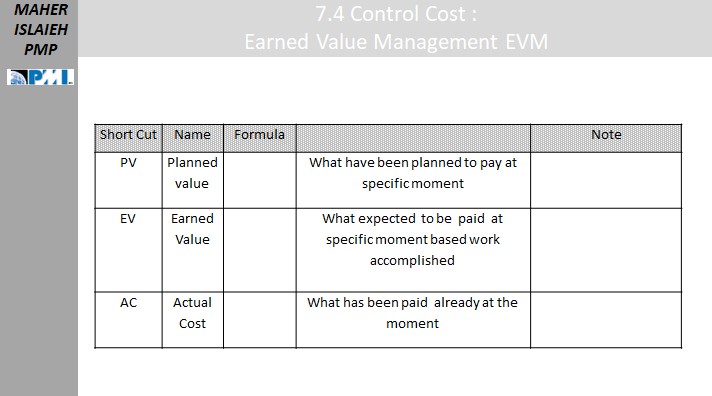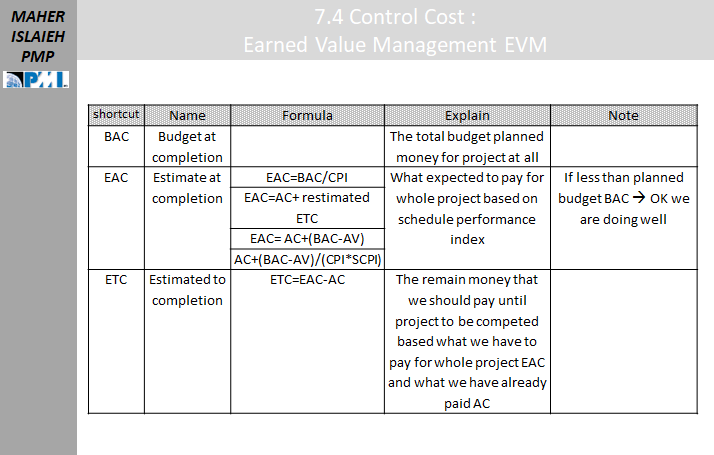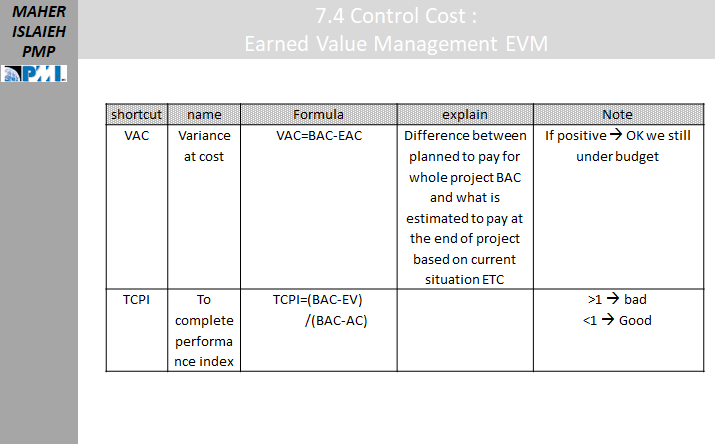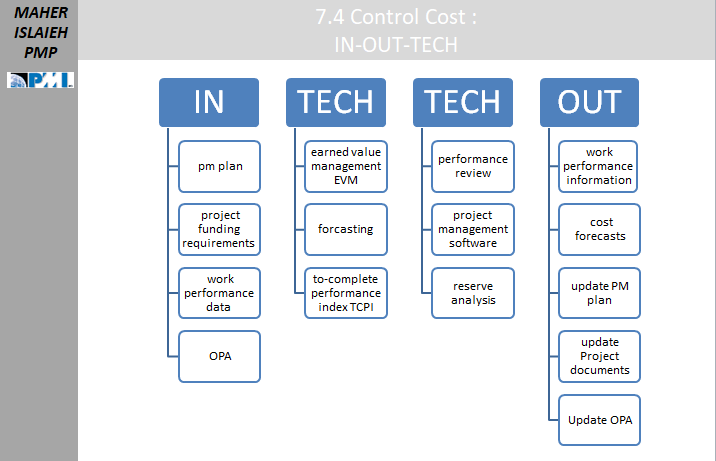introduction
Control Costs is the process of monitoring the status of the project to update the project costs and managing changes to the cost baseline.
The key benefit of this process is that it provides the means to recognize variance from the plan in order to take corrective action and minimize risk.
Control Cost concepts
Control Cost concepts
- Project manager calculate the total amount of fund that organization need to be available for project
- progress reporting :
- some traditional project manager just ask project team about percentage of achieved work , which is NOT enough
- excellent project manager uses EVM Earned value management to control their project
- contingency reserve : check is contingency reserve is still needed or whether new reserve is required
- Earned Value Management : Earned value measurement is a great reporting tool. With it, you can show where you stand on budget and schedule, as well as provide forecasts for the rest of the project.
EVM : Earned Value Management
Earned value management is a project management technique for measuring project performance and progress. It has the ability to combine measurements of the project management triangle: scope, time, and costs
EVM work to estimate :
- Planned value
- Earned Value
- Actual Cost
- Cost variance
- Schedule variance
- Cost performance index
- Schedule Performance Index
- Name
- Budget at completion
- Estimate at completion
- Estimated to completion
- Variance at cost
- To complete performance
her in networks pioneers we have summarize EVM formulas as below
Control Cost : inputs - Techniques - Outputs
Inputs
- pm plan
- project funding requirements
- work performance data
- OPA
Techniques
- earned value management EVM
- forecasting
- to-complete performance index TCPI
- performance review
- project management software
- reserve analysis
Outputs
- work performance information
- cost forecasts
- update PM plan
- update Project documents
- Update OPA
Control Costs: Inputs
Project Management Plan
1- Cost Management Plan
it contains guidelines on how to do all the other processes in the cost management knowledge area, including this one. Here are some specific guidelines that pertain to process 7.4 Control Costs
- Rules of performance measurement–Earned Value Management or EVM is a tool used in monitoring the performance of a project, including whether it is ahead of, on, or behind schedule. The rules of how EVM will be used on the project should be specified, usually using one of the two measures Schedule Performance Index (SPI) or Schedule Variance (SV).
- Control thresholds–once a variance is detected, the threshold should be set (usually in terms of a percentage deviation from the baseline plan as expressed in the SPI) ,so that any amount of variation above that threshold will cause certain actions to be taken.
- Reporting formats–when the work performance reports are sent to the stakeholders, the formats of those reports, which stakeholders receive them, and the frequency of those reports should be specified.
2- Cost baseline
- this is an output of the last process 7.3 Determine Budget, and it represents the budget according to plan; it is what the actual costs are compared to in order to determine whether a variance exists.
3- Performance measurement baseline
- this is used in earned value analysis, which takes the three constraints of scope, schedule and cost and combines them to create a baseline from which to compare the actual results in terms of schedule and cost. In the case of cost management, the quantities used are the Cost Performance Index (CPI) and the Cost Variance (CV).
Project Documents
- The lessons learned register, an output of process 4.4 Manage Project Knowledge, is updated during this process to see if there are any procedures done by the project team that improve cost control; these lessons are stored in the register to be used later on in the project, and possibly on future projects as well.
Project Funding Requirements
- This is another output of the previous process 7.3 Determine Budget. This is done if the money for the project budget is not available from the parent organization all at once, and if it is supplied for use by the project team in increments. In this case, the funding limits for each period are set up, and so it is important for the project manager to make sure that the expenditures during each period do not exceed the amount given by the periodic funding limit.
Work Performance Data
- This is an output of process 4.3 Direct and Manage Project Work. The data that pertains to this process include the actual costs that have authorized, incurred, invoiced and paid for activities done on the project.
Organizational Process Assets
- Policies, procedures and guidelines related to cost control (should be included in the Cost Management Plan), including methods for monitoring, controlling, and reporting information related to costs
- Cost control tools (the Project Management Information System, if created by another company as in the case of Microsoft Project, is considered an Enterprise Environmental Factor; if a tool is proprietary and created by the organization doing the project, it is an Organizational Process Asset)
control cost : techniques
Planning the Project Budget
- You would need to ideally make a budget at the beginning of the planning session with regard to the project at hand. It is this budget that you would have to help you for all payments that need to be made and costs that you will incur during the project life cycle. The making of this budget therefore entails a lot of research and critical thinking.
- Like any other budget, you would always have to leave room for adjustments as the costs may not remain the same right through the period of the project. Adhering to the project budget at all times is key to the profit from project.
Keeping a Track of Costs
- Keeping track of all actual costs is also equally important as any other technique. Here, it is best to prepare a budget that is time-based. This will help you keep track of the budget of a project in each of its phases. The actual costs will have to be tracked against the periodic targets that have been set out in the budget. These targets could be on a monthly or weekly basis or even yearly if the project will go on for long.
- This is much easier to work with rather than having one complete budget for the entire period of the project. If any new work is required to be carried out, you would need to make estimations for this and see if it can be accommodated with the final amount in the budget. If not, you may have to work on necessary arrangements for ‘Change Requests’, where the client will pay for the new work or the changes.
Effective Time Management
- Another effective technique would be effective time management. Although this technique does apply to various management areas, it is very important with regard to project cost control.
- The reason for this is that the cost of your project could keep rising if you are unable to meet the project deadlines; the longer the project is dragged on for, the higher the costs incurred which effectively means that the budget will be exceeded.
- The project manager would need to constantly remind his/her team of the important deadlines of the project in order to ensure that work is completed on time.
Project Change Control
- Project change control is yet another vital technique. Change control systems are essential to take into account any potential changes that could occur during the course of the project.
- This is due to the fact that each change to the scope of the project will have an impact on the deadlines of the deliverables, so the changes may increase project cost by increasing the effort needed for the project.
Use of Earned Value
- Similarly, in order to identify the value of the work that has been carried out thus far, it is very helpful to use the accounting technique commonly known as ‘Earned Value’.
- This is particularly helpful for large projects and will help you make any quick changes that are absolutely essential for the success of the project.
Expert Judgments
You want to make use of the expert judgment of either people on your project team or others who have expertise in the following areas:
- Earned value analysis (one of the main Data Analysis Techniques to uncover whether there is a variance between the actual costs of activities and the planned costs for those activities according to the project budget)
- Variance analysis (one of the Data Analysis Techniques done to determine the source of the variance if one is uncovered during earned value analysis)
- Trend analysis and forecasting (including the To-Complete Performance Index or TCPI, these Data Analysis Techniques will show what will happen to the project as a whole, either with regards to the overall project schedule or budget, if current trends continue that are uncovered by earned value analysis)
- Financial analysis (especially to see if funding for project is remaining within project funding requirements)
Project Management Information System (PMIS)
This is a tool, rather than a technique, and it is the software system used to monitor the three basic quantities used in earned value analysis, namely PV (planned value), EV (earned value), and AC (actual cost). and to assist with trend analysis and forecasting.
In the next post, then, we will start discussing Data Analysis Techniques starting with earned value analysis. This is important not just for project managers doing a project, but for those studying for the PMP exam, because PMI loves asking questions about earned value analysis on the certification exam!
cost control : outputs
Work Performance Information
One of the inputs to this process was work performance data, which represented in the case of this process the actual costs associated with the activities done in the last reporting period. Among other things, this process takes those actual costs and compares them to the costs that were projected as part of the project budget, and determines whether there are any variances
Cost Forecasts
As one of the results of trend analysis and forecasting, two data analysis techniques used in this process, an estimate of how much the project will now cost in order to complete may be done, and this quantity called the Estimate At Completion or EAC may be documented for inclusion in reports to stakeholders.
Change Requests
As mentioned above in paragraph 7.4.3.1, if variances between the actual costs and the proposed costs (i.e., what is in the project budget) are uncovered by this process, there may be change requests proposed in order to correct these variances and to bring the costs in line with what is in the plan or budget. These change requests are then input, as are all other change requests from different knowledge areas, to the main change control process 4.6 Perform Integrated Change Control.f
Project Management Plan Updates
As a result of this process, some of the components of the project management plan may be updated. These include the following:
1- Cost management plan
- feedback from relevant stakeholders may require a change request to moderate the guidelines for this process, including control thresholds or specified levels of accuracy when reporting the project’s cost.
2- Cost baseline
- e–if there are any changes in cost estimates uncovered as a result of this process, the change request may require changes to the cost baseline. Remember, a change request can either
- change the work to fit the plan (with a defect repair, corrective action, or preventive action)
- change the plan to fit the work (if the original cost estimates prove to be unrealistic based on new knowledge gained in the last reporting cycle)
3- Performance measurement baseline
- any approved changes in the cost baseline will affect the performance measurement baseline. For example, if there are changes in cost estimates for a given activity, the planned value or PV of that activity may change, and when that activity is completed, its earned value of that value may change as well. Since all of the earned value analysis measurements such as SPI, SV, CPI, and CV depend on the value of EV, this will have an effect on those derived values as well.
- If the effect on the performance measurement baseline is large, it may require recalculating the project budget as a whole (the budget at completion or BAC) and/or the remaining budget to be spent (the estimate to completion or ETC).
